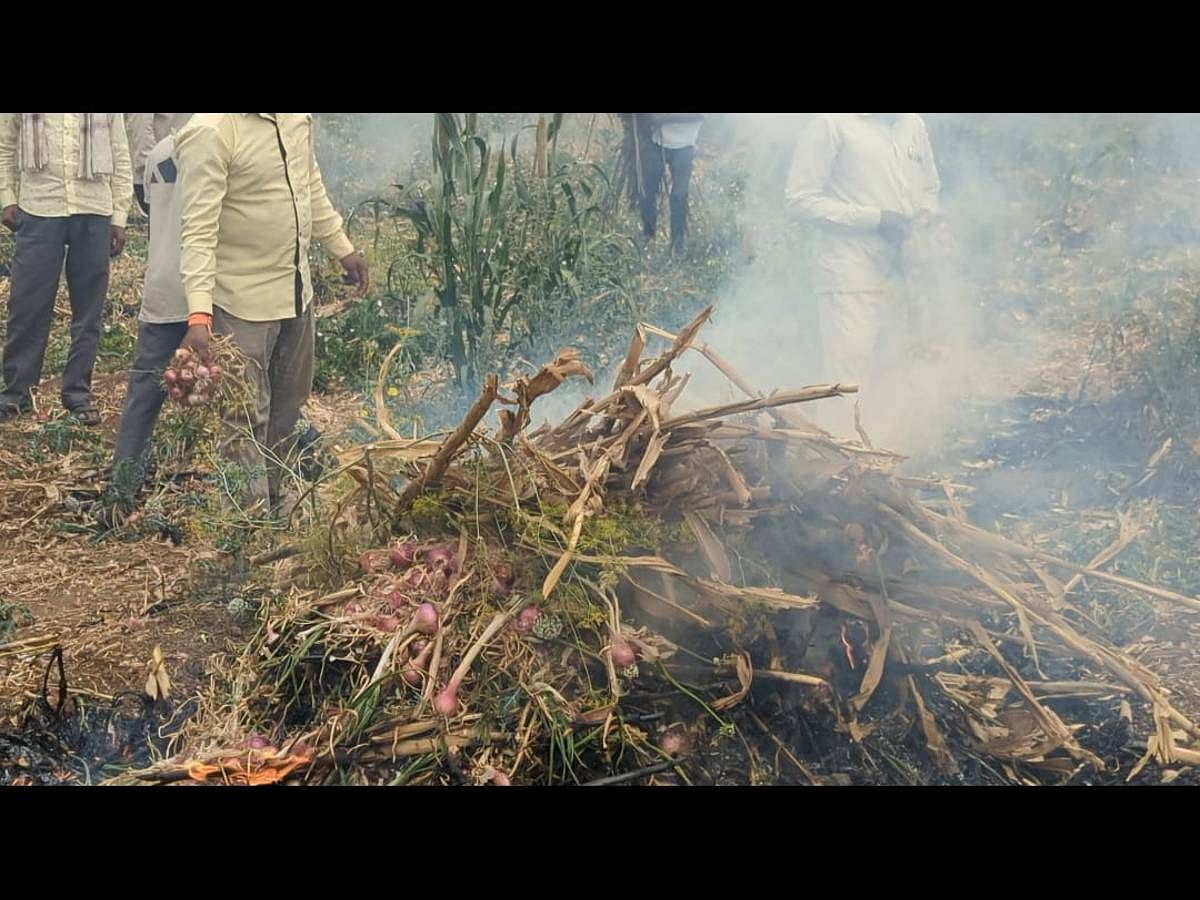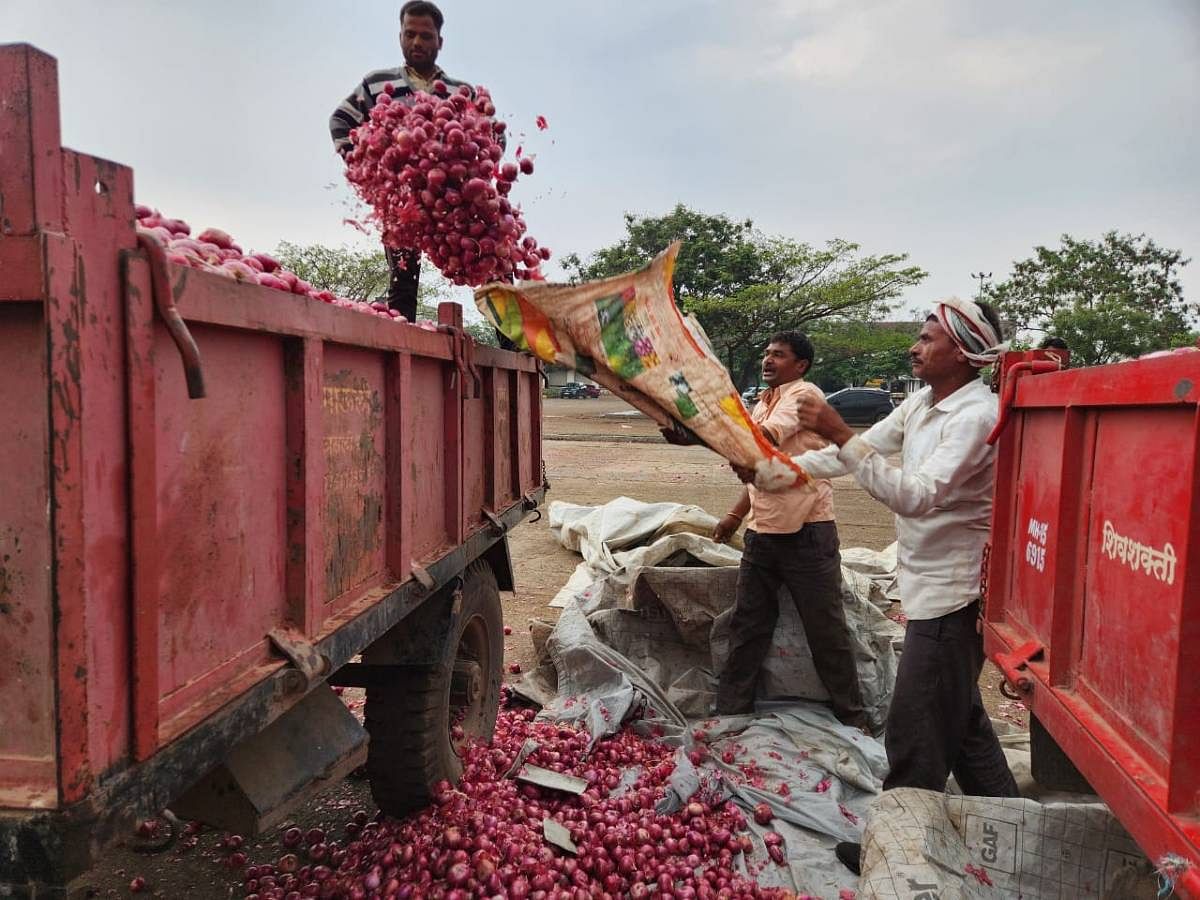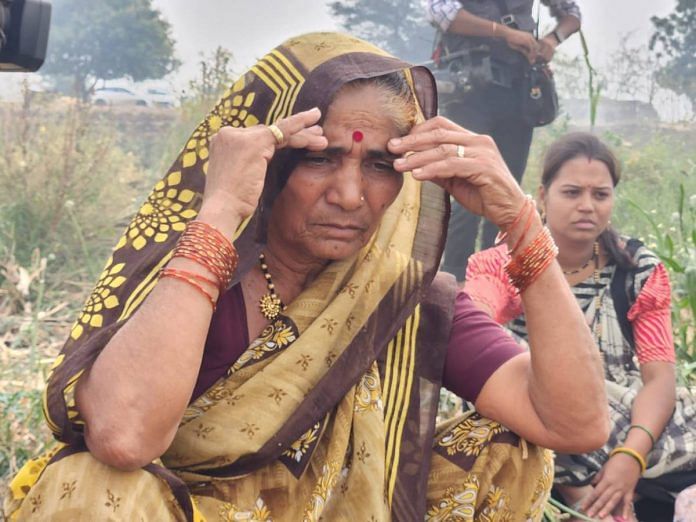Lasalgaon (Nashik): On Monday morning, ahead of Holi, Krishna Dongre, a farmer from Yeola taluka in Nashik district burnt his Holika (a festival marked by the burning of bonfires) — 150 quintals of onion crop he grew on his one-and-a-half-acre land in the presence of his family, who were all in tears.
Dongre had even written a letter in blood (a copy of the letter is with ThePrint) to the Chief Minister and printed invites about “his Holi” Monday but received no response. “It has been 15 days since I sent the invitation to the Chief Minister and the Deputy Chief Minister about this Holi, but nobody cared to respond,” he said.
However, Dongre is not alone. The crash in onion prices for the past three weeks has brought tears to the eyes of several farmers in this Nashik district.
According to the commodity prices index, until 4 February, the onion prices at Lasalgaon were Rs 1,151 per quintal, which dropped to Rs 550 around February 26-27, and currently stands at Rs 700 per quintal.
The crash has angered the farmers in the region, who had stopped the auction at the Agriculture Produce Market Committee (APMC) last week for a day.
According to Dongre, the transportation cost to take the produce to the market is an added trouble, which only multiplies his loss. “I would have earned only Rs 2-4 per/kg. I had no other option, but to burn the crop,” he said.
But for Dongre, his is just one of the many stories from his region for which he blames the government. “My crop is gone, but there are many who need help. The government should do something for them,” he said.
For the government, the work has already begun. The National Agricultural Cooperative Marketing Federation (NAFED), a state-run farm produce trader, has started its procurement activities in Nashik.
Moreover, the Maharashtra chief minister Eknath Shinde had also announced on the floor of the Assembly that they have started buying out surplus onions from Nashik — Asia’s biggest onion market — through NAFED.
Also Read: Govt to continue rice export restrictions to ensure domestic price stability, adequate stocks
‘Let the farmers live’
Squatting close to Krishna Dongre on his farm was his mother Mandabai and the entire family. “There is no price for onions today. We pay for the labour, transport, and high-seed fertiliser, but to no returns. What do we do? Are we left with any options,” the mother cried.

For Mandabai, the crop was no less than her child, which she nurtured with as much care. “Since nobody is taking note of us, what options do we farmers have, but to die by suicide,” she said.
On the same afternoon, Eknath Ghumre, a farmer from Chandwad taluka in Nashik, was at the Lasalgaon APMC market with 15 quintals of onions. He told ThePrint that he already sold 15 quintals in the morning and had another 15 at home.
“I get only Rs 650 per quintal, which is roughly Rs 29,000, but I have already invested Rs 50,000. We need at least Rs 1,500-2,000 per quintal, or else we suffer a loss. The transportation cost is also high, we need the government to intervene and help us,” Ghumre said.
Just a little ahead, Bhausaheb Kondaji Dukre, another farmer from Chandwad taluka in Nashik, narrated a similar story.
“I grew around 650-700 quintals of onions on my six-acre farm. I invested around Rs 70,000 per acre and received Rs 550 per/kg on average. The government just gives assurances and promises, but does nothing to help us,” Dukre told ThePrint.
The farmer also questioned the government’s claims of intervention. “If the government says it has started buying the crop, where is it? The inflation is high, we can’t afford much. We need a base price of at least Rs 1,000 per kg. The government should give us compensation,” he added.
The traders at the market agreed with this assessment. “The production cost is around Rs 1,100-1,200 per quintal, and the farmers are getting way less,” they said.
Due to constant fluctuation in prices, most farmers ThePrint spoke to said they needed a minimum base price for onion.
Mandabai, too, urged for the same. “We need a minimum support price. The government does not pay any attention to us. What should we as parents do if our sons die by suicide? Let the farmers live,” she said.

Lasalgaon APMC market during auction | Photo Purva Chitnis | ThePrint
What led to the crash in price?
According to the traders and APMC management, sudden change in temperature and rise in import duties from neighbouring countries are some of the reasons behind the crash in onion prices.
Onions are cultivated in three seasons — Kharif (sowed in June-July and harvested in September-October), late-Kharif (sowed in September-October and harvested in January-February) and Rabi (sowed in December-January and harvested in March-April).
Kharif and late-Kharif crops contain high moisture and have a shelf life of about a month, while the Rabi crops can be stored for six months, the traders of Lasalgaon explained to ThePrint.
The farmers sell their produce in batches. The Kharif crop comes in the market starting November-December right up to February, while the late-Kharif crop stays in market until April and then the Rabi crop is marketed, they added.
However, this time, with the sudden rise in temperature, the farmers harvested their late-Kharif crop early, and the market is now witnessing a bumper crop, said Manoj Jain, trader and owner of Jain export at Lasalgaon APMC market.
“The quality of red onions is also bad. The colour, skin, size is not good and has also contributed to the fall in prices,” Jain added.
According to Sangeeta Shroff, professor of politics and economics, at Gokhale Institute, apart from the bumper crop, the farmers are also expecting rain in the coming days.
“They are scared of the weather and, therefore, are harvesting early, which has led to higher onion stock in the market. And because there is expectation that the next crop will also flood the market, prices have crashed, “she said.
According to the Lasalgaon Agriculture Produce Market Committee (APMC) data, as of Monday, on a daily average, the market is getting flooded with 35,000-40,000 quintals of onion against 50,000 to 55,000 quintals last week.
According to the APMC data — the copy of which ThePrint has access to — in the past five years, February 2022-23 has seen the highest produce being brought to the market — 11.64 lakh quintal against 8.97 lakh quintal last year and 10 lakh quintals in 2018-19.
In 2018-19, 64.34 lakh quintals of onion were brought to the market, while last fiscal (2021-22) it was 85.3 lakh quintal for the entire year. The figure has already touched 84.2 lakh quintals until February this fiscal.
“We are expecting this to be the highest yield in the past five years. But, due to the government’s intervention to some extent, and the farmers’ hesitation to bring their produce to the market, the APMC has witnessed a drop,” said a member of APMC market, who did not want to be named.
Lasalgaon gets onions from Nashik, Ahmednagar, Dhule, Jalgaon, Nandurbar and Aurangabad. The onions from here are exported to Bangladesh, Sri Lanka, Saudi Arabia, Pakistan (via Dubai).
“The higher import duties in Bangladesh are also a cause of concern and so is Sri Lanka and Saudi Arabia. The central government needs to intervene so that our exports can be normal,” said the APMC member quoted above.
Maharashtra accounts for about 40 per cent of India’s annual onion production of 25-26 million tonnes (MT), of which 1.5-1.6 MT is exported. Besides Maharashtra, Madhya Pradesh (16-17 per cent) Karnataka (9-10 per cent), Gujarat (6-7 per cent), Rajasthan and Bihar (5-6 per cent each) are major producers.
According to Shroff, since states like Madhya Pradesh have also started producing onions, the export of Maharashtra onions has suffered. “We should explore newer regions for export like Northeast. The government should expand to more markets,” Shroff added.
Also Read: Govt panel to assess impact of higher temperatures on wheat crop, say officials
Government intervention
On 28 February, Chief Minister Eknath Shinde told the assembly that the government has intervened, and through NAFED, the buying process has started.
“NAFED has opened limited centres in the district, which will likely go up by Monday. The central government’s move will provide stability to the onion market. NAFED has also planned to procure Rabi onions from April for buffer stocking. The major procurement takes place in the Nashik district. Farmers are requested to bring their good quality and dried stock to the procurement centres to avail of better rates at these centres. The payment will be made online,” the NAFED release read.
On the ground, when ThePrint met the traders from NAFED, they said they had started the purchase process from 2 March.
Chandrashekhar Shinde, a trader with NAFED’s Krushnadhara Farma producer company told ThePrint that NAFED does not generally buy red onions that come out in Kharif season but are bulk buyers of pink onions from the Rabi season. The NAFED buys onions that have a size above 45 mm up to 65 mm at approximately Rs 900 per quintal.
“However, this time, due to the crash we have started buying red onions too,” he said.
When asked what stops the farmers from coming to NAFED directly, Shinde explained, “They are unaware that we are buying via NAFED. They are even scared because they receive payments with a delay of 10-12 days.”
So far, since 2 March, Shinde’s company has bought 1,140 quintals of onions, which is 350 quintals daily.
But will NAFED’s intervention be of much help to the farmers? According to Manoj Jain, it would not. “NAFED has a limit of how much they can buy. Instead, if the government buys through APMC and open markets, that will have a bigger impact on farmers,” he said.
And is there a possible solution to the crisis? According to Shroff, dehydration of onions could be one possible answer. “We need to generate the demand for dehydrated onions so that they can last longer. Just the government buying the onions won’t help as they will only rot in the godown. The government should have processing units to dehydrate onions.”
(Edited by Richa Mishra)
Also Read: After India, Bangladesh & Vietnam, now Philippines harvests GM Golden Rice to cure ‘hidden hunger’



